History of Russian
Comfrey, part 1
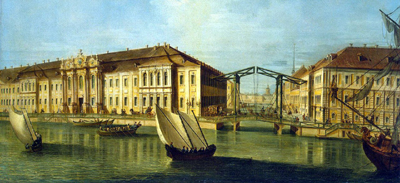
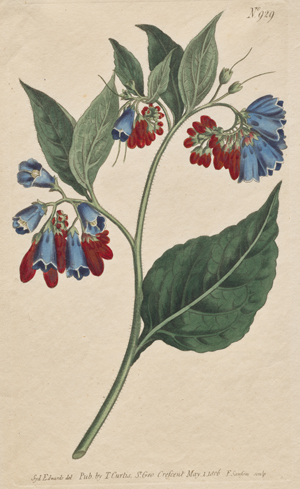
Symphytum Asperrimum (Prickly Comfrey)
1806 Curtis's Botanical Magazine
Plate 929
|
Saint Petersburg Palace in Russia, 1771
“In 1771, Joseph Busch, a landscape gardener of Hackney (London borough, England), sold his nursery to Conrad Loddige and set sail with his family to lay out gardens of St. Petersburg Palace for Catherine II (The Great) of Russia.
In the 1790s he sent Symphytums back to the Loddiges, as I found from the bound copy of their cataogue for 1836 in Hackney Public Library. One of these species was Symphytum asperrimum, with striking cobalt-blue flowers very welcome in the borders of the 18th century.”
-Fighting Like the Flowers: An Autobiography: The Life Story of Britain’s Best-Known Organic Gardener by Lawrence D. Hills. Bideford, Devon, England: Green Books, 1989, page 100.
“The original cross of Russian Comfrey was probably a natural hybridization that took place in the collection of Symphytums gathered by Joseph Busch, the Hackney (London, England) landscape gardener who laid out the grounds of St. Petersburg Palace for Catherine II (the Great) of Russia.
Plants were sent from there from 1870 onwards (other Symphytums were sent earlier, the first in 1790), and the latest import is reported to have been in 1900.”
-Comfrey: Nature’s Healing Herb & Health Food by Andrew Hughes. Japan: Sanyusha Publishing, 1992, page 136.
“A rare chance natural hybridization appears to have occurred between the yellow S. officinale (Common Comfrey) found all over Europe including Russia, and the blue S. asperrimum (Prickly Comfrey) planted side by side in the Symphytum border.”
-Fighting Like the Flowers: An Autobiography: The Life Story of Britain’s Best-Known Organic Gardener by Lawrence D. Hills. Bideford, Devon, England: Green Books, 1989, page 100. (This created Russian Comfrey.) |
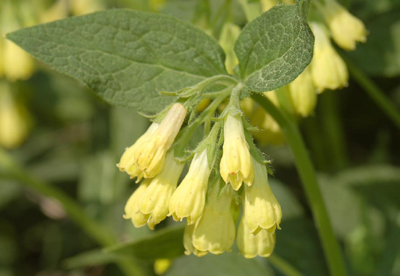
Symphytum Officinale with Yellow Flowers
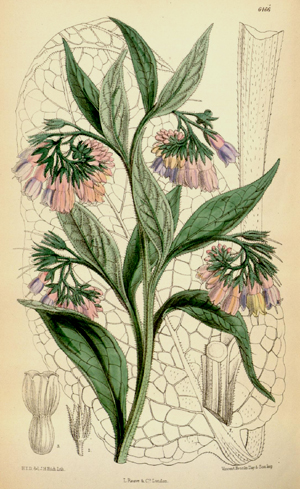
Symphytum peregrinum,
1879 Curtis's Botanical Magazine,
Plate 6466
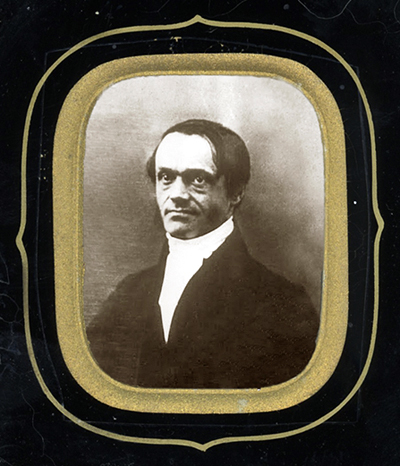
Henry Doubleday, 1810-1902
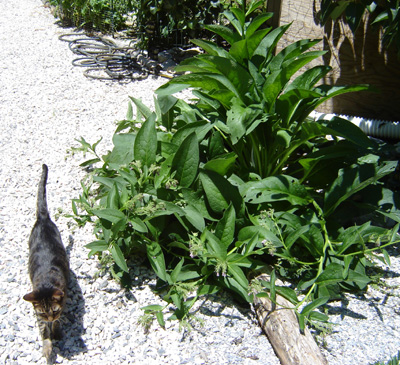
Russian Comfrey Bocking No. 4
|
Henry Doubleday,
England, 1870
Henry Doubleday, scientist and horticulturalist, 1810-1902, was the son of a Quaker grocer from Coggeshall, Essex County, England. He was the first person to improve Comfrey by selecting best plants for propagation.
His work was recognised by Lawrence D Hills, who named the ‘Henry Doubleday Research Association’ after him. It is now called ‘Garden Organic’ and is the largest organic gardening and horticultural organization in Europe.
“The cultivation of Comfrey seems to have become very popular from 1870 onwards, when Henry Doubleday of Coggeshall, Essex, England, imported Symphytum x uplandicum (Russian Comfrey) from Leningrad (then St. Petersburg, Russia).
The figure (artwork) in ‘Curtis Botanical Magazine’, plate 6466 (*1879) under the name of Symphytum peregrinum was drawn from plants presented to Kew Gardens in 1875 by Thomas Christy, who was associated with Doubleday in his efforts to popularise its cultivation.
Several seedsmen took up the distribution of the plant, including Messrs. Sutton of Reading, Berkshire, England, who continued to supply it until 1896.
In 1900 Messrs. Webster of Stock, Essex, England, imported it from Russia, and they and other nurserymen still carry stocks (as of 1958). These and other introductions from Russia and elsewhere are undoubtedly the chief, if not the sole, origin of S. x uplandicum in Britain.”
-‘The History of Symphytum Asperum Lepech. and S. x Uplandicum in Britain’ by A.E. Wade, Department of Botany, National Museum of Wales, Watsonia, Volume 4, pages 117-118, 1958. (Watsonia was the journal of the ‘Botanical Society of Britain and Ireland’ from 1949 to 2010. It is now called ‘New Journal of Botany’.)
(* -‘Curtis's Botanical Magazine, Comprising the Plants of the Royal Gardens of Kew, and of Other Botanical Establishments in Great Britain, Volume 105 of Whole Work, Or Volume 35 of Third Series’ by Sir Joseph Dalton Hooker, M.D., C.B., K.C.S.I., F.R.S., F.L.S., London, England, 1879.)
“In general, estimates before the 1870’s give from 40-60 tons an acre for Comfrey; the greater the number of cuts quoted, the higher the estimated yield.
From 1875 onwards we come to yields of 100 to 120 tons. They spring from
Henry Doubleday of Coggeshall, Essex, England, a small farmer but a great
experimenter, who imported from Saint Petersburg, Russia, what is either
Symphytum peregrinum, which grows 4,000 feet (1219 meters) above sea-level
near Sawunt in the Talsch Province of the Caucasus, or a hybrid of S.
officinale and S. asperrimum known as S. x uplandicum.
Between them (Doubleday and Thomas Christy {1831-1905}) they began the boom in Russian Comfrey, as they called the new plant to distinguish it from the earlier Prickly Comfrey, S. asperriumum.”
-Russian Comfrey: A Hundred Tons an Acre of Stock or Compost for Farm, Garden or Smallholding by Lawrence D. Hills. London England: Faber and Faber, Limited, 1953, page 28.
“This new type (Russian Comfrey) reached 6 feet 8 inches in height (over 2 meters) when allowed to flower, and was carefully chosen for its various superior characteristics by Henry Doubleday. It was from this plant that the highest yields of that time were obtained in England, recording 100 tons per acre (25,000 kg per 1/4 acre).”
-Comfrey: Nature’s Healing Herb & Health Food by Andrew Hughes. Japan: Sanyusha Publishing, 1992, page 124.
“Henry grew his seedlings and called his F1 hybrid ‘Doubleday’s Solid Stem Comfrey’ or ‘Russian Comfrey’ to distinguish it from the earlier introduction.
Henry devoted the last 30 years of his life to research on this crop, leaving the marketing to Thomas Christy, a nurseryman of Sydenham (southeast London, England). It was his dream that his crop would feed a hungry world.
We shall never know what he found, for when he died the family said, ‘Poor Uncle Henry, he never made any money’, and they tidied up all his papers and burned the lot.
Though he was awarded the proud title of ‘Fellow of the Royal Society’ for his introduction of Russian Comfrey in 1875, he could never afford registration fee of 12 guineas so could not use the letters ‘F.R.S’ to which he was entitled.”
-Fighting Like the Flowers: An Autobiography: The Life Story of Britain’s Best-Known Organic Gardener by Lawrence D. Hills. Bideford, Devon, England: Green Books, 1989, pages 100, 103.
|
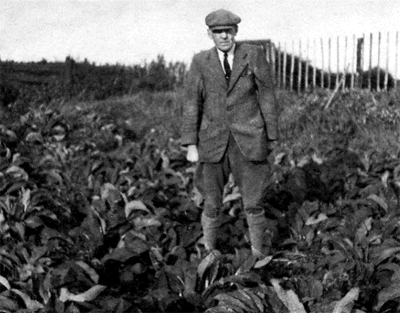
Vernon Stephenson,
1894-1974
in comfrey field for feeding his race horses
|
Vernon
Stephenson, England, 1942
“Vernon Stephenson planted his acre of Russian Comfrey in 1942, buying his plants from the late Kenneth Crawley of Lockerbie, Dumfriesshire County of Dumfries, England, who grew a different set of variations from those I had at Southery, Norfolk, England- the mainly large-leafed, heavy-stemmed, Webster strain. His had a high proportion of a thin-stemmed, early variety with the same magenta flowers.
Among my (Lawrence D. Hills) fans was E.V. (Edmund Vernon) Stephenson of Hunsley House Stud, Little Weighton, near Hull, Yorkshire, England, who wanted me to visit him to talk about Comfrey. By the time I visited him, 10 years later (in 1952), he had learnt a great deal about feeding Comfrey to both horses and pigs.”
-Fighting Like the Flowers: An Autobiography: The Life Story of Britain’s Best-Known Organic Gardener by Lawrence D. Hills. Bideford, Devon, England: Green Books, 1989, page 95.
|
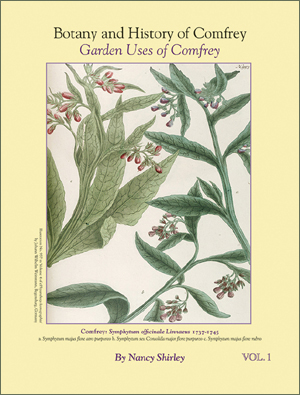
Find out
more about Russian Comfrey in
chapter 10 of
Botany
and History of Comfrey;
Garden Uses of Comfrey
|
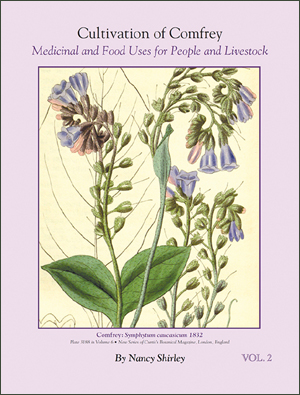
Find out
more about Russian Comfrey in
Cultivation
of Comfrey:
Medicinal and Food Uses for People and Livetstock
|
|







